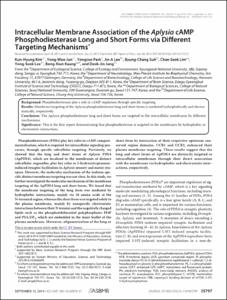Full metadata record
| DC Field | Value | Language |
|---|---|---|
| dc.contributor.author | Kim, Kun-Hyung | - |
| dc.contributor.author | Jun, Yong-Woo | - |
| dc.contributor.author | Park, Yongsoo | - |
| dc.contributor.author | Lee, Jin-A | - |
| dc.contributor.author | Suh, Byung-Chang | - |
| dc.contributor.author | Lim, Chae-Seok | - |
| dc.contributor.author | Lee, Yong-Seok | - |
| dc.contributor.author | Kaang, Bong-Kiun | - |
| dc.contributor.author | Jang, Deok-Jin | - |
| dc.date.available | 2017-05-11T01:53:03Z | - |
| dc.date.created | 2017-04-10 | - |
| dc.date.issued | 2014-09 | - |
| dc.identifier.issn | 0021-9258 | - |
| dc.identifier.uri | http://hdl.handle.net/20.500.11750/1676 | - |
| dc.description.abstract | Phosphodiesterases (PDEs) play key roles in cAMP compartmentalization, which is required for intracellular signaling processes, through specific subcellular targeting. Previously, we showed that the long and short forms of Aplysia PDE4 (ApPDE4), which are localized to the membranes of distinct subcellular organelles, play key roles in 5-hydroxytryptamineinduced synaptic facilitation in Aplysia sensory and motor synapses. However, the molecular mechanism of the isoform-specific distinct membrane targeting was not clear. In this study, we further investigated the molecular mechanism of the membrane targeting of the ApPDE4 long and short forms. We found that the membrane targeting of the long form was mediated by hydrophobic interactions, mainly via 16 amino acids at the N-terminal region, whereas the short form was targeted solely to the plasma membrane, mainly by nonspecific electrostatic interactions between theirNtermini and the negatively charged lipids such as the phosphatidylinositol polyphosphates PI4P and PI(4,5)P |
- |
| dc.publisher | American Society for Biochemistry and Molecular Biology Inc. | - |
| dc.title | Intracellular Membrane Association of the Aplysia cAMP Phosphodiesterase Long and Short Forms via Different Targeting Mechanisms | - |
| dc.type | Article | - |
| dc.identifier.doi | 10.1074/jbc.M114.572222 | - |
| dc.identifier.scopusid | 2-s2.0-84907164523 | - |
| dc.identifier.bibliographicCitation | Journal of Biological Chemistry, v.289, no.37, pp.25797 - 25811 | - |
| dc.description.isOpenAccess | FALSE | - |
| dc.subject.keywordPlus | PLECKSTRIN HOMOLOGY DOMAIN | - |
| dc.subject.keywordPlus | TERMINAL SPLICE REGION | - |
| dc.subject.keywordPlus | PLASMA-MEMBRANE | - |
| dc.subject.keywordPlus | PHOSPHATIDYLINOSITOL 4,5-BISPHOSPHATE | - |
| dc.subject.keywordPlus | DROSOPHILA-MELANOGASTER | - |
| dc.subject.keywordPlus | ELECTROSTATIC SWITCH | - |
| dc.subject.keywordPlus | HIGH-AFFINITY | - |
| dc.subject.keywordPlus | LOCALIZATION | - |
| dc.subject.keywordPlus | UNIQUE | - |
| dc.subject.keywordPlus | MEMORY | - |
| dc.citation.endPage | 25811 | - |
| dc.citation.number | 37 | - |
| dc.citation.startPage | 25797 | - |
| dc.citation.title | Journal of Biological Chemistry | - |
| dc.citation.volume | 289 | - |
- Files in This Item:
-
 기타 데이터 / 3.55 MB / Adobe PDF
download
기타 데이터 / 3.55 MB / Adobe PDF
download
- Appears in Collections:
- Department of Brain Sciences Laboratory of Brain Signal and Synapse Research 1. Journal Articles



